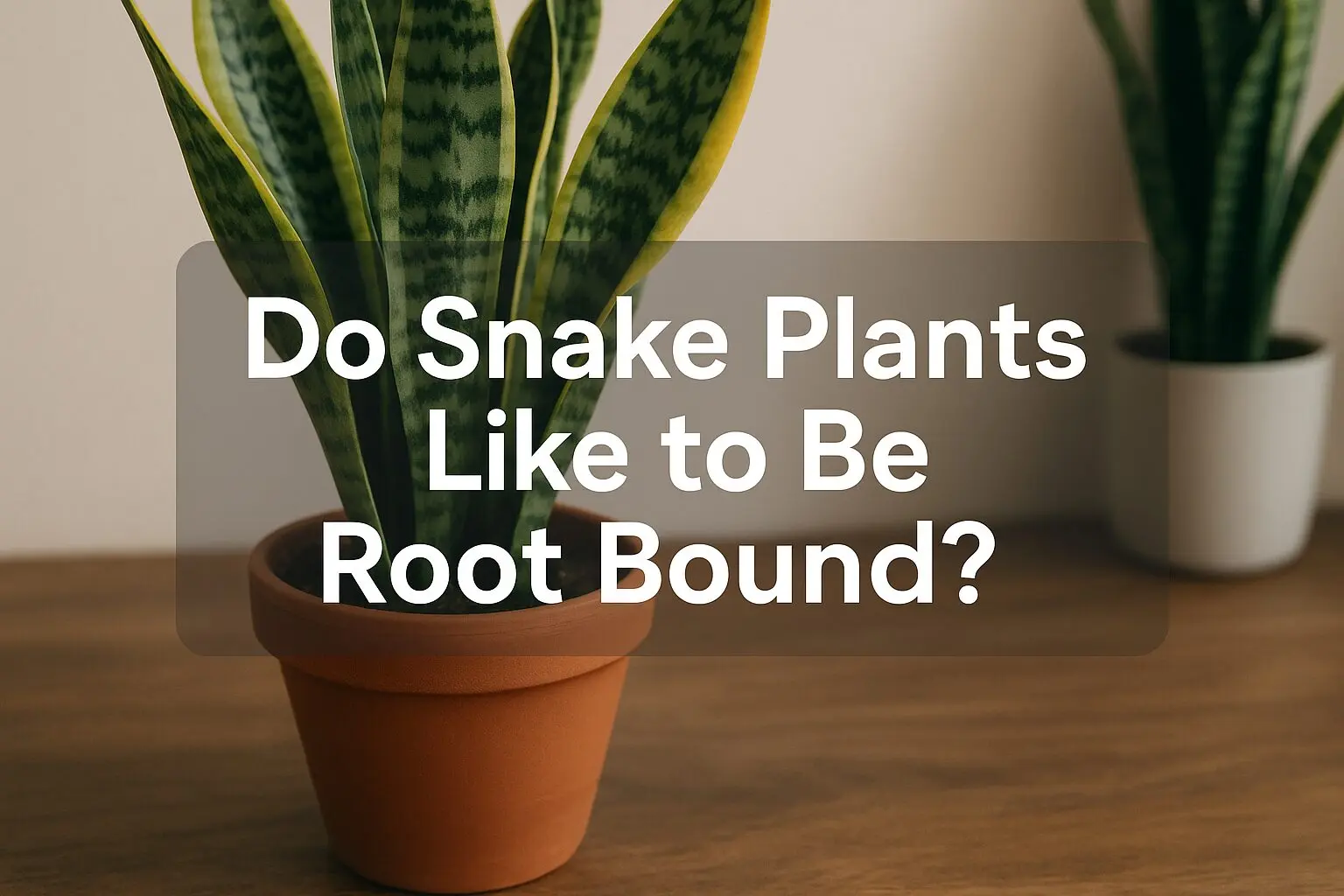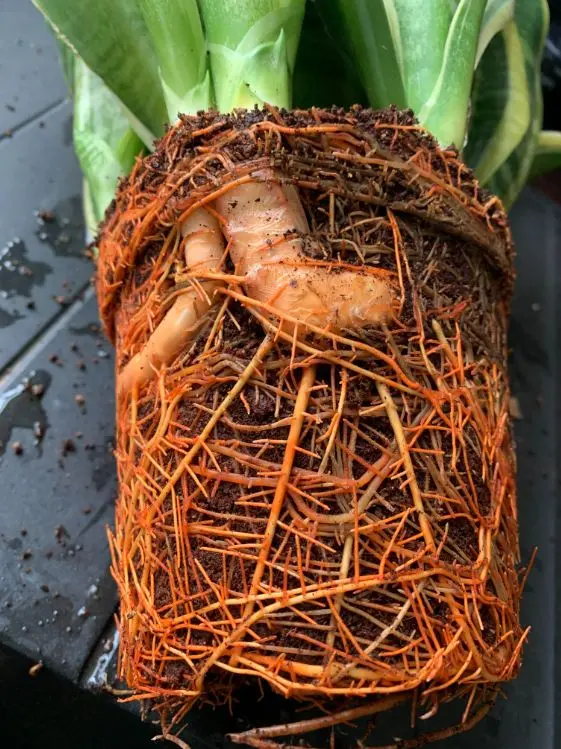Do Snake Plants Like to Be Root Bound?

You’ve probably heard someone say snake plants like being root bound. This plant advice gets shared a lot. But what does it really mean for your plant? Let me explain the truth behind this common houseplant tip.
Table of Contents
What Does Root Bound Mean?
When your snake plant becomes root bound, its roots pack into the pot like people in a crowded elevator. The roots circle around inside the container. They take up more space than the soil itself. It’s your plant’s way of saying it outgrew its current home.
Most houseplants hate this. But snake plants are different. They seem to do better when their roots are snug in their container. Think of it like wearing well-fitted jeans versus baggy pants. Sometimes the tighter fit just works better.
Do Snake Plants Like to Be Root Bound?
Yes, but there are important details. Snake plants actually perform better when they’re a bit cramped. When their roots fill the pot, these plants often make more new growth. They grow pups (baby plants) and even flower more.
This preference comes from their natural growing spots. In their native African home, snake plants grow in tight spaces with limited root room. They learned to make the most of cramped quarters.
But there’s a big difference between “slightly root bound” and “way too root bound.” Your plant can handle being snug. It shouldn’t be bursting out of its pot or showing stress signs though.
Signs Your Snake Plant Has Hit Its Limit
Although these plants thrive in tight spaces, they will eventually require more room. Watch for these warning signs:
- Roots escaping the pot: When you see thick white roots poking out of drainage holes, your plant needs help. Or when they push up through the soil surface.
- Slowed or stopped growth: If your snake plant hasn’t made new leaves in over a year, overcrowded roots might be the problem. This happens even with good care.
- Yellowing leaves: When roots can’t soak up nutrients due to overcrowding, older leaves start turning yellow and mushy.
- Water runs straight through: If water flows out the bottom right away when you water, there might be more roots than soil in the pot.
- The pot is cracking: Snake plant roots are pretty strong. They can actually crack ceramic and clay pots when they run out of space.
Benefits of Keeping Snake Plants Root Bound
There are good reasons why snake plants prefer snug quarters:
- Better growth patterns: Root bound snake plants often focus energy on making new shoots rather than growing their root system. This means more of those beautiful tall leaves.
- Less overwatering risk: Smaller pots dry out faster. This suits these drought-loving plants perfectly. Too much soil can hold extra moisture and cause root rot.
- More flowers and pups: Stress from tight quarters often makes snake plants reproduce. You might see those rare snake plant flowers or notice baby plants appearing.
- Easier care: Smaller pots are lighter to move and need less water. This makes your plant care routine simpler.
When Root Bound Becomes a Problem?
While snake plants handle tight conditions well, being severely root bound causes real problems:
- Nutrient shortage: When roots take up most of the pot space, there’s little soil left to hold nutrients. Your plant might show pale or stunted growth.
- Watering troubles: Really packed roots can stop water from reaching all parts of the root system. Some areas stay dry while others stay soggy.
- Stability issues: Heavy top growth in a small pot creates an unstable situation. Your plant might tip over easily.
- Stunted growth: Eventually, even snake plants hit their limit and stop growing when root bound conditions become severe.
How to Check If Your Plant Needs Repotting?
The best way to check your snake plant’s root situation is through a gentle look:
- Check the drainage holes: Look for roots coming out the bottom of the pot
- Feel the soil surface: Push your finger into the soil near the edges. If it feels like solid root mass, it’s time to act
- Lift the pot: If your plant feels unusually heavy for its size, roots might have replaced most of the soil
- Remove from pot: For a clear answer, carefully slide your plant out of its container and look at the root ball
Pot Size for Snake Plants
When you do repot, don’t go too big. Snake plants prefer wide, shallow containers rather than deep pots. Pick a new pot that’s only 1-2 inches wider than the current one.
- Pot depth: These plants have shallow root systems. So a pot that’s wider than it is deep works best. Deep pots can trap water at the bottom and cause root rot.
- Material: Clay and ceramic pots work well because they let extra moisture escape through the walls. Plastic pots hold more moisture. So you’ll need to change your watering schedule.
- Drainage: Whatever pot you pick, make sure it has drainage holes. Even drought-loving snake plants can’t survive in standing water.
Best Practices for Repotting
When your snake plant finally needs a new home, timing and method matter:
- Pick the right season: Spring and summer are best because your plant is actively growing. It can recover faster from the stress.
- Use proper soil: A well-draining mix made for cacti and succulents works perfectly. Regular potting soil holds too much moisture.
- Don’t water right away: Wait a few days after repotting before watering. This lets any damaged roots heal and reduces shock.
- Divide if needed: This is the perfect time to separate pups from the mother plant if you want to create new plants.
How Long Can You Wait?
Snake plants are really patient. You can often leave them in the same pot for 3-5 years without problems. Sometimes longer. Some plant lovers report having snake plants in the same container for over ten years with good results.
The key is watching your plant’s health rather than following a strict schedule. As long as your snake plant keeps making new growth and has healthy-looking leaves, you can probably wait.
Conclusion
Snake plants really do prefer being root bound. But like most things in plant care, balance is key. These tough plants do well in snug containers that would stress other houseplants. But they still have limits. Watch for signs that your plant has outgrown its space. When in doubt, remember that snake plants are forgiving. They’d rather be slightly too crowded than swimming in extra soil and moisture.
Frequently Asked Questions (F.A.Q)
How often should I repot my snake plant?
Most snake plants need repotting every 2-4 years, sometimes longer. Check yearly for signs of severe overcrowding. But don’t repot just because it’s been a certain amount of time.
What happens if I put my snake plant in a pot that’s too big?
Big pots hold too much moisture and can lead to root rot. Your snake plant might also focus energy on root growth instead of making the attractive tall leaves you want to see.
Can I leave my snake plant root bound forever?
While snake plants handle being root bound better than most plants, they’ll need more space eventually. Watch for signs like yellowing leaves, stopped growth, or roots breaking through the pot.
Should I pick a deep or shallow pot for my snake plant?
Shallow, wide pots work best. Snake plants have spreading root systems that grow sideways rather than deep down. A pot that’s wider than it is tall suits them perfectly.
Is it normal for snake plant roots to come out of drainage holes?
A few roots poking through drainage holes is normal and not necessarily a problem. But if you see thick masses of roots or multiple roots coming out, it’s probably time to think about repotting.







